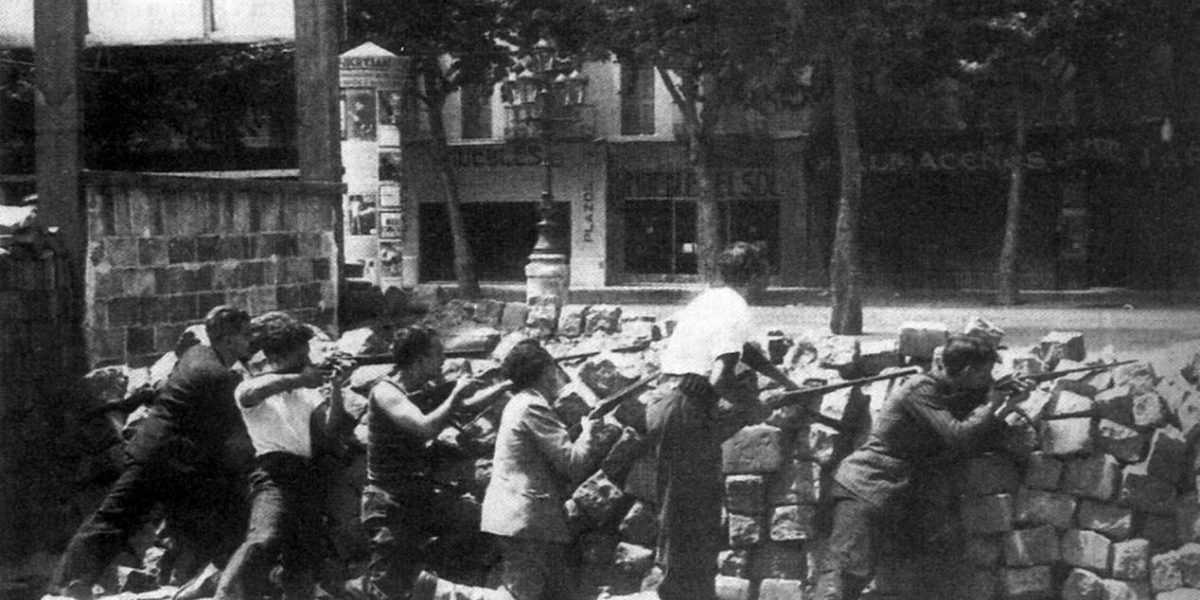When we think of the Spanish Civil War and the Confederacion Nacional de Trabajo (CNT), workers that fought for anarchism & anti-fascism, there are many heroic accounts of the events of 1936-39, including authors such as George Orwell and his book Homage to Catalonia. Chris Ealham’s Anarchism and the City is a comprehensive guide to the history of the development of Catalunya, and Barcelona more specifically, from the late 19th century right up to the May Days of 1937, when the Esquerra Republicana de Catalunya (ERC) took back control of Barcelona. Ealham covers the changing geography and industrialisation of the region, its citizens, and the various political groups and organisations that defined this tumultuous period of proletarian struggle.
The early chapters explore the workings of Barcelona; its crammed working-class areas that were sharply divided from the bourgeois suburbs of the city, and how that division fostered the radical working-class culture that the CNT was an integral part of. The rapid influx of immigrant workers from other areas of Spain, deplorable living conditions and the violently repressive police that maintained order for the Restoration government and the reactionary Primo de Rivera government that followed, along with the absence of any kind of welfare state, created a strong culture in the barris against the state and the police. Chapter 5 details how this culture, and the CNT’s centrality to working-class life, expressed itself in self-management of unemployment services, education, and community self-defense.
The book then turns to the early days of the Second Republic and the role of radical organisations, including the CNT, in helping bring about the end to the Restoration era in Spain. Through the San Sebastian pact and the acquiescence of the CNT to the republican movement’s desires, the proletariat helped usher in the end of the Spanish monarchy; this joyous time turned into a new repressive nightmare as the new liberal governments returned to acting in the bourgeoisie’s interests shortly after taking power. The development of the working classes and its activities during the Second Republic were ‘decisive’ for what happened during the Civil War, according to Antonio Elorza.
Next, are the chapters that describe the development of the CNT itself during the late 20s and early 30s. Contrary to the general idea of one unified, big union that moved as one large mass, Ealham highlights how riven and chaotic the workings of the CNT really were; the tensions between the reformist treintistas, insurrectionists, the Bloc, and other factions led to the splitting of the CNT, as the radical elements of the union tried to marginalise its critics in the labour movement. As the 30s rolled on and parts of the CNT membership became more militarised and enmeshed in violent industrial conflicts, Ealham analyses the political limitations of the union and the Federación Anarquista Ibérica (FAI) that tried to intervene in it, which set the scene for the successes and failures of the CNT and the proletariat of Catalonia during the Civil War.
For those who are wanting more context of why events in the Spanish Civil War happened, how the anarchists managed to win self-management for the proletariat for nearly a year in Barcelona before their allies moved to retake control, and what lessons can be learned from the story of the Catalonian working classes’ story of the early 20th century, this book is a fantastic introduction to that history. It is an enjoyable read, a fairly deep dive into the events of 1898 to 1937, and helps us to understand the material conditions that formed the movement which achieved an anarchist revolution for a fleeting moment.
The book is available from AK Press, and a copy has made its way onto The Anarchist Library.
